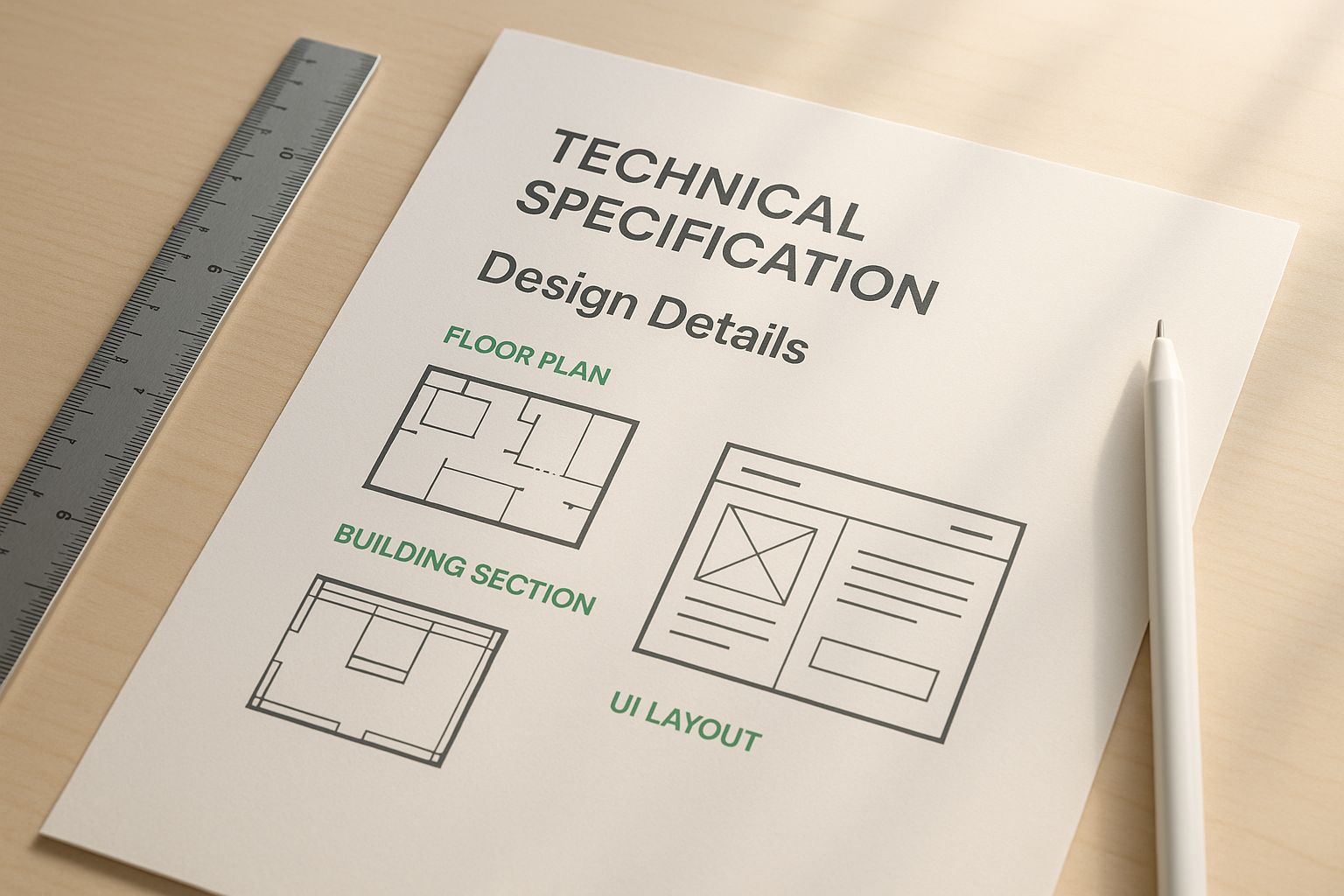A practical guide to writing technical specification documents that prevent scope creep and align teams. Learn to build project blueprints that ensure success.
Think of a technical specification document as the architectural blueprint for your project. It’s the detailed plan that takes a brilliant product idea and translates it into a concrete set of requirements, goals, and limitations. At its core, it’s the roadmap that keeps your entire development team on the same page, all working toward the same finish line.

Imagine building a house. You wouldn’t just show up with a pile of lumber and start hammering away, right? That would be a recipe for disaster—a chaotic, unstable mess that looks nothing like the dream home you had in mind. The same exact principle applies to software development. Your technical specification document is that indispensable blueprint.
This doc becomes the single source of truth for the entire project. It cuts through the ambiguity that so often leads to classic project killers like scope creep, blown deadlines, and busted budgets. It acts as the bridge between the business vision and the technical execution, making sure what gets built is exactly what was intended.
When you strip it all down, a technical specification document is a communication tool. A really, really important one. It ensures everyone involved—from project managers and developers to QA testers and stakeholders—shares the exact same understanding of the project’s goals. That alignment is what separates efficient, successful projects from the ones that flounder.
Without it, teams are just operating on assumptions. A developer might interpret a feature request one way, while the product manager who wrote it meant something completely different. The result? Frustrating rework and wasted time. A solid spec document prevents this by nailing down the specifics:
To really get the most out of a TSD, it helps to understand its place within the larger development framework. Familiarizing yourself with the Software Development Life Cycle (SDLC) phases shows you how these specs form the bedrock of the entire process, right from the initial requirements phase.
A TSD’s role can be broken down into several key functions that benefit everyone on the team.
As you can see, this document does more than just list features; it provides a strategic framework that guides the project from start to finish.
Ultimately, putting in the time to create a comprehensive TSD pays off big time. It makes development smoother, testing simpler, and gives everyone a clear benchmark for success. And while this guide focuses on technical specs, it’s just one piece of the puzzle. To see how they fit into the bigger picture, check out our overview on what are technical documents.
Creating these documents doesn’t have to be a chore. Tools like DocuWriter.ai use AI to help you generate clear, comprehensive technical specifications in a fraction of the time, making sure your project starts with the clarity it needs to succeed.
Struggling to create technical documentation that is clear, consistent, and comprehensive? DocuWriter.ai uses advanced AI to automate the generation of code, API, and technical specification documents, saving your team valuable time while improving accuracy. Stop writing from scratch and start building smarter at https://www.docuwriter.ai/.

Starting a software project without a technical specification is like trying to build a house without a blueprint. You might have a great idea of what you want it to look like, but without a plan, you’re heading for chaos, wasted materials, and a structure that might just collapse.
A well-written spec doc isn’t just another piece of paperwork. It’s the roadmap that turns a vague concept into a tangible, buildable product. Its most powerful function is creating a unified vision, making sure everyone—from the CEO to the junior developer—is on the exact same page. It’s what stops the costly guesswork that leads to endless, soul-crushing rework cycles.
A solid technical spec acts as a universal translator between different teams. Business stakeholders can finally see the project’s scope and limitations in black and white, while developers get the granular detail they need to actually build the thing.
This completely eliminates those dreaded, “Oh, I thought you meant…” conversations that can derail a project for weeks.
In the world of SaaS, where things move incredibly fast, clear communication is everything. A technical spec document becomes the single source of truth, ensuring every decision is informed and intentional. This is a core pillar of effective SaaS Product Management strategies.
Beyond just getting everyone aligned, a TSD is a powerful tool for sniffing out problems early. The very act of writing one forces your team to think through potential roadblocks, dependencies, and architectural headaches before a single line of code is ever written.
Catching these issues upfront saves an unbelievable amount of time and money down the road. It’s the difference between adjusting a blueprint and tearing down a wall you just built.
This foresight has a massive ripple effect on project planning. With a detailed spec in hand, your estimates for timelines, budgets, and staffing become far more accurate. Your QA team will love you, too, because every requirement is clearly defined and testable, which ultimately leads to a much higher-quality product.
The value of a technical specification document doesn’t end at launch. It becomes a living history of your project, explaining why certain decisions were made. This is absolutely critical for long-term maintenance, future updates, and hunting down pesky bugs.
When new engineers join the team, the TSD is their best friend. It gets them up to speed on the system’s logic and architecture in days, not months. You’re no longer relying on that one senior dev who remembers everything—the knowledge is preserved, ensuring the project can grow and scale for years to come.
Struggling to create technical documentation that is clear, consistent, and comprehensive? DocuWriter.ai uses advanced AI to automate the generation of code, API, and technical specification documents, saving your team valuable time while improving accuracy. Stop writing from scratch and start building smarter at https://www.docuwriter.ai/.
A really effective technical specification document is so much more than a checklist of features. It’s the story that guides a project from a rough idea into a finished product. I like to think of it as the detailed schematic for a complex machine—every single section has a job to do, building on the last one to create a complete, crystal-clear picture of what you’re building.
Let’s pull back the curtain and look at the essential parts that make up a spec you can actually build from.
This infographic gives you a bird’s-eye view of how a solid tech spec is put together, flowing from the high-level summary all the way down to detailed wireframes and diagrams.

As you can see, a logical structure is everything. It makes sure every detail has a home, making the entire document easy for anyone to pick up and understand.
Every great spec kicks off with a simple, direct introduction. This isn’t the time for fancy jargon. Your goal here is to state the problem you’re solving and give a quick, high-level summary of how you plan to solve it. Anyone, technical or not, should be able to read it and get the gist immediately.
Right after that, you need to define the project’s goals and non-goals. It’s obvious why you’d state what the project will do, but it’s just as important to explicitly list what it won’t do. Trust me, this one simple step is your best defense against scope creep later on.
Getting this right from the start sets rock-solid expectations for everyone involved.
Now we’re getting to the heart of the technical specification document. This is where you translate those big-picture goals into tangible, concrete requirements. It’s absolutely critical to split them into two different categories to keep things clear.
Functional Requirements describe what the system actually does from a user’s point of view. They’re all about actions and behaviors. A classic example would be, “A user must be able to reset their password via an email link.”
Non-Functional Requirements, on the other hand, define how the system needs to perform. These are the qualities, constraints, and operational standards of the system.
Some common non-functional requirements include:
Once the requirements are locked in, it’s time to map out the technical plan. This section gives everyone a high-level look at the system’s architecture, how the data will be structured, and any other major design choices.
To make this easier to digest, we can break down the key sections of a technical specification document into a simple table.
This table serves as a great checklist to ensure you’re covering all your bases and creating a document that is truly comprehensive.
The System Architecture part often includes diagrams (like flowcharts or sequence diagrams) to visually show how different pieces of the system talk to each other. This helps developers wrap their heads around the overall structure and the way data moves through it.
Next, the Data Model gets into the weeds of how information will be stored and organized. This could include database schemas or definitions of key data entities. A solid data model is what stops integration nightmares before they start.
Finally, the UI/UX Specifications section might include things like wireframes, mockups, or links to design files. Even in a deeply technical doc, you have to connect the engineering work to the actual user experience. If you want to see how this all comes together in a real-world project, checking out a complete technical requirement document sample can be incredibly helpful.
Pulling all these details together can feel like a mountain of work, but it’s non-negotiable for a successful project. To speed things up, tools like DocuWriter.ai can help generate structured, comprehensive technical documents, ensuring you cover every critical component with precision and consistency.
Struggling to create technical documentation that is clear, consistent, and comprehensive? DocuWriter.ai uses advanced AI to automate the generation of code, API, and technical specification documents, saving your team valuable time while improving accuracy. Stop writing from scratch and start building smarter at https://www.docuwriter.ai/.
A solid structure is a great starting point, but the real magic of a technical spec happens in the writing. A brilliantly organized document can still fall flat if the content is vague, confusing, or left open to interpretation. You need to write with such precision that ambiguity has nowhere to hide.
This is where your spec transforms from a simple document into a catalyst for action. It’s part art, part science—a meticulous approach where every word is chosen for its clarity. This isn’t just about listing features; it’s about creating a shared understanding that gets everyone on the project rowing in the same direction.
The golden rule here is to be clear, concise, and unambiguous. Ditch the jargon when simple language works better, and always define acronyms or niche terms the first time you use them. Remember, your audience isn’t just engineers; non-technical stakeholders need to grasp the project’s direction, too.
A great way to do this is by writing testable requirements. Instead of a woolly statement like “the page should load quickly,” a testable requirement is concrete: “The user dashboard must load in under 2 seconds on a standard broadband connection.” This gives developers a clear target to hit and lets QA know exactly what to verify.
Technical specs should never be written in a vacuum. The best ones are born from collaboration. The author—whether that’s a product manager or a lead engineer—is really a facilitator, pulling insights from a whole team of stakeholders.
This back-and-forth is crucial for covering all your bases and making sure the final document is both comprehensive and realistic. Here’s a quick breakdown of who you need in the room:
Juggling feedback from this many people can feel like herding cats, but it’s the only way to create a document that everyone is truly bought into.
Words can only take you so far, especially when you’re trying to describe a complex system. Sometimes, a single, well-placed diagram explains a concept far better than several paragraphs of text ever could. Visuals aren’t just fluff; they are powerful tools for clarity.
Try weaving these into your specs to break up the text and boost understanding:
These visuals act as quick reference points, helping readers grasp complex relationships at a glance without getting bogged down in dense descriptions.
A technical spec is a living document. That’s especially true in agile environments where requirements are expected to evolve. Without a strict system for tracking changes, your spec can become outdated and useless almost overnight. Rigorous version control is not optional.
Every single change, no matter how small, needs to be documented. Note who made the change, when they made it, and why. This creates a transparent audit trail that prevents confusion and guarantees everyone is working from the latest draft. A clear revision history helps the whole team understand how the project has evolved and the thinking behind key decisions.
Crafting and managing these documents is a lot of work, but this is where modern tools can really change the game. An AI-powered platform like DocuWriter.ai helps streamline the entire process. It can help draft clearer language, automatically format sections for readability, and maintain consistency across the board, making sure your tech specs stay the reliable source of truth they need to be.
Struggling to create technical documentation that is clear, consistent, and comprehensive? DocuWriter.ai uses advanced AI to automate the generation of code, API, and technical specification documents, saving your team valuable time while improving accuracy. Stop writing from scratch and start building smarter at https://www.docuwriter.ai/.
Let’s be honest, static text documents are starting to feel like a relic from a bygone era. The whole process of creating technical specifications is changing, becoming more intelligent, more dynamic, and deeply integrated into how we build things. This isn’t just a minor tweak; it’s a fundamental shift driven by AI and the simple fact that teams need richer, more accessible information to get their jobs done.
The future isn’t just about what’s written down. It’s about how that information is delivered and used. As teams grow and projects get more complex, clarity is everything. That means bringing multimedia directly into the documentation to explain things better and give people the context they need.